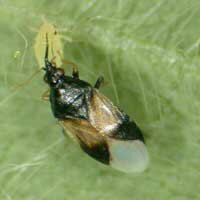
-
Soybean Diseases
- Asian Rust
- Anthracnose
- Bacterial Blight
- Bacterial Pustule
- Bean Pod Mottle Virus
- Brown Stem Rot
- Cercospora Leaf Blight
- Charcoal Rot
- Downy Mildew
- Frogeye Leaf Spot
- Green Stem Syndrome
- Iron Deficiency Chlorosis
- Phytophthora Root & Stem Rot
- Powdery Mildew
- Rhizoctonia
- Seedling Diseases
- Septoria (Brown Spot)
- SCN (Soybean Cyst Nematode)
- Soybean Mosaic Virus
- Stem Canker
- Sudden Death Syndrome
- Viruses
- White Mold
- Soybean Pests
- Diagnostic Help
- Field Trials
- Soybean Library
Your Soybean Checkoff.
Delivering Results.
Illinois
Indiana
Iowa
Kansas
Michigan
Minnesota
Missouri
Nebraska
North Dakota
Ohio
South Dakota
Wisconsin
Natural Enemies of Insect Pests in Field Crops
 |
| A common predator, Orius spp. (pirate bug) preying on an aphid. Photo credit: S. Yoo, Purdue University |
Biological control is the use of living beneficial organisms, also called natural enemies, for the control of pests.
Birds, mammals and reptiles feed on insect pests, but the most important group of natural enemies are insects that feed on other insects. These beneficial insects occur abundantly in cropland and provide a significant amount of control of some crop pests.
It’s important to recognize that the intent of biological control is not to eradicate the pest population, but to keep them at levels where they cause no appreciable harm. In fact, because natural enemies require prey or hosts for survival, biological control works best when there is always a small population of pests to sustain their natural enemies. This is a major difference between biological control and the use of pesticides.
Biological control can be easily and effectively supplemented with cultural and carefully-chosen chemical controls when necessary.
Insecticides and biocontrol efficacy
The use of broad-spectrum insecticides is one of the main obstacles to effective biological control because natural enemies are just as susceptible to the insecticide as the pest.
Sometimes one pest will be under good biological control, but another one is reaching an economic threshold. This is often what causes a secondary pest outbreak in which the pest that was not causing damage becomes damaging after treatment eliminated its natural enemies.
A similar situation, called pest resurgence, occurs when the population of the treated pest, especially aphids, rebounds rapidly because of the elimination of its natural enemies.
 |
| Green lacewing larva is a common insect predator. Photo credit: Whitney Cranshaw, Colorado State University |
Types of natural enemies of soybean pests
Natural enemies of insect pests fall into three categories: general predatory insects, parasitic insects, and insect pathogens (fungi, bacteria or nematodes).
Predatory insects are usually much larger than their prey. They are generally voracious feeders that kill and eat a wide variety of insects as they grow and reproduce. Ground beetles, minute pirate bugs, and ladybeetles are examples of predatory insects.
Most predators are fairly mobile and can search for their prey. Many predators are active in both their immature larval or nymph stage as well as adults. You and your scout will learn to recognize common predatory insects in both their immature and adult stages.
Some of the most effective natural enemies, however, are tiny and easily overlooked. Many of these are insect parasites, also called parasitoids, which are often tiny, non-stinging wasps. Parasitic wasps are free-living in the adult stage, but in the larval stage are parasitic on specific insects. The parasitic larvae eat their hosts from within, ultimately resulting in the death of the host insect.
When scouting for this type of biological control activity, you will look for signs of the parasitized pest rather than the parasite itself. Binodoxys communis is an example of an aphid parasite.
Insect pathogens are a third type of natural enemy. Insect pathogens are microorganisms that cause lethal disease in insect pests. The most well-known insect pathogen is Bacillus thuringensis, or Bt which has been made into a commercially available microbial insecticide.
Fungi that attack insect pests are called entomogenous fungi and are fairly common. Under rainy, humid conditions, death caused by fungal infection can be a major mortality factor for aphids. Under some conditions, entire aphid populations can be wiped out. However, most of the time infection does not occur early enough or often enough to be an important control agent. Fungicide sprays may kill entomogenous fungi.
Resources on biological control with natural enemies
- Biological control of insects and mites: An introduction to beneficial natural enemies and their use in pest management. University of Wisconsin Cooperative Extension Publication A3842. Mahr, D.L., Whitaker, P., Ridgway, N.M. 2008 (print copies available from the University of Wisconsin Learning Store).
- Illinois Natural History Survey : The Good Guys - Natural Enemies of Insects
- Biological Control of Insect Pests on Field Crops in Kansas (pdf)
- Biological Control: A Guide to Natural Enemies in North America (website)
